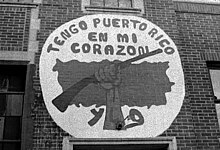Iris Morales
In highschool, Morales was highly inspired by Malcolm X and Don Pedro Albizu Campos, because there was little understood about Puerto Rican history.[10][11][12][13] The Chicago-based Young Lords, a leftist group of Puerto Rican youth activists inspired by the Black Panthers, established a branch in New York in 1969.Her engagement in the feminist movement was astute, as she worked to deconstruct the patriarchal sexism that followed women at the beginning of their journey in the Young Lords Party.[19][20] On November 11, 1970, Iris Morales along with Denise Oliver, Nydia Mercado, and Lulu Carreras, were highlighted in The New York Times under the section titled Food, Family, and Fashion."[21] This feature was important to the feminist movement and caucus of the Young Lords Party, because it was the first documentation and acknowledgment of women's involvements in the Mainstream Media.After the dissolution of the Young Lords, Morales continued her Latina feminist activism and pursued a Juris Doctor degree from New York University School of Law.[14] She later worked with Manhattan Neighborhood Network's community media center in Spanish Harlem[13][24] and served as director of the Union Square Awards, a city government project recognizing grassroots activists.Morales's hopes are to continue to inspire the future activists with historical narratives, and anthologies of present day social issues.Iris Morales founded the Red Sugarcane Press that has dedicated its purpose to continuing to publish works relating to the Latinx community.The anthology is made up of different genres of writing that aimed to address the perspectives of Latina women and their views of gender, equality, race and political refrains in the modern society.As a co-author to Raquel M. Ortiz, Morales worked alongside her to create a tale that retells the Young Lord's journey and story in a digestible way for children.Some people were set to create books and other forms of media to commemorate the time; Iris Morales volunteered to direct the film.The idea served as a means of allowing young LatinX people to find a medium and space to continue to preserve the history of their communities.
Young LordsJulia Richman High SchoolStudent Nonviolent Coordinating CommitteeMalcolm XPedro Albizu CamposBlack Panther PartyEast HarlemVietnam WarCity CollegeBlack PanthersJosé Cha Cha JiménezCOINTELPROmachistaThe New York TimesJuris DoctorNew York University School of LawRoot-Tilden-Kern ScholarshipManhattan Neighborhood NetworkHunter CollegeHurricane MariaNew York TimesLincoln HospitaltuberculosisLatinoJustice PRLDEFWomen of the Young Lords